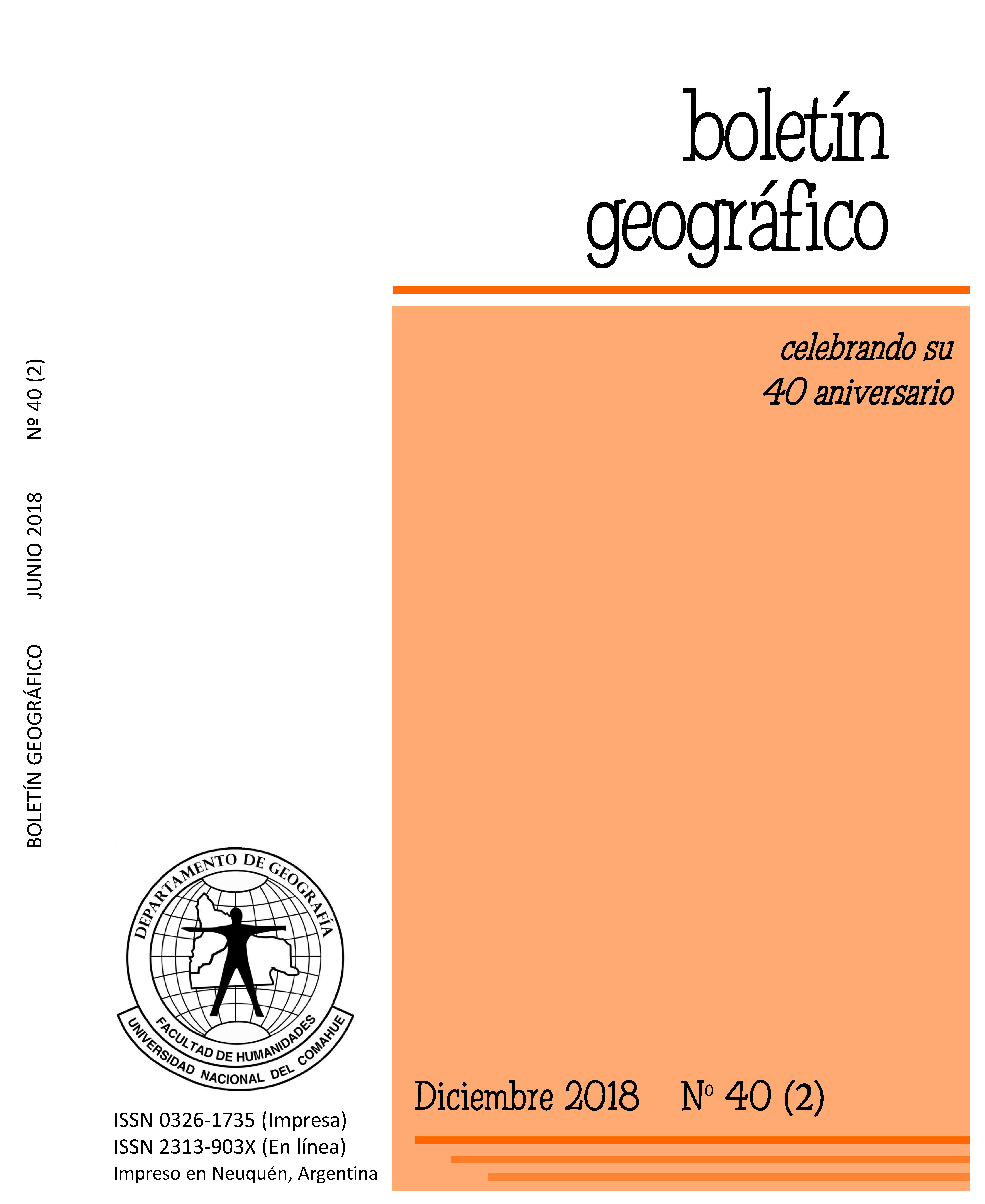Análisis del balance hídrico medio mensual en la provincia del Neuquén (Argentina)
Palabras clave:
Thornthwaite, Balance hídrico, Evapotranspiración, EscorrentíaResumen
En los últimos años se ha producido un aumento de la temperatura media en distintas regiones, lo que se asocia con un aumento en la evapotranspiración, provocando mayor déficit y estrés hídrico en zonas con climas áridos. El clima de la provincia del Neuquén presenta un marcado gradiente de precipitaciones oeste-este, en áreas cercanas a la cordillera de los Andes se destacan inviernos fríos con lluvias y nevadas, y veranos más secos y templados; hacia el este disminuye la precipitación presentando un ambiente semidesértico identificado con la estepa patagónica. El conocimiento de la evolución de las distintas componentes del balance hídrico en zonas áridas es de fundamental importancia para la estimación de la cobertura vegetal y sus requerimientos hídricos, considerando las diversas actividades productivas que se desarrollan en la región. En el presente trabajo se presentan en detalle las variaciones espaciales de las componentes del balance de humedad, a partir de información de superficie de la red estaciones meteorológicas de la provincia del Neuquén.Descargas
Citas
Cabrera, A. (1985). Enciclopedia Argentina de Agricultura y Jardinería. Tomo II.
Regiones Fitogeográficas Argentinas. Segunda Edición. ACME S.A.C.I.
Dai, A., Trenberth, K.E. & Qian, T. (2004). A global dataset of Palmer drought
severity index for 1870–2002: relationship with soil moisture and effects of surface warming. Journal of Hydrometeorology. 5, 1117–1130
Fasullo, J. & Sun, D.Z. (2001). Radiative Sensitivity to Water Vapor under All-Sky
Conditions
García N.O. (1994). South America Climatology. Quaternary International, 21, 7-27.
Garreaud, R. D., & Aceituno, P. (2001). Atmospheric circulation over South America: Mean features and variability. Chapter 2 in: The Physical Geography of South America. T. Veblen, K. Young and A. Orme, Eds. Oxford University Press.
Harris, I., Jones, P.D., Osborn, T.J. & Lister, D.H. (2014). Updated high-resolution
grids of monthly climatic observations – the CRU TS3.10 Dataset. International
Journal of Climatology, 34, 623–642. doi: 10.1002/joc.3711.
Jones P.D., Lister D.H., Osborn T.J., Harpham C., Salmon M. & Morice C.P., (2012):
Hemispheric and large-scale land surface air temperature variations: an extensive
revision and an update to 2010. Journal of Geophysical Research 117, D05127. doi:10.1029/2011JD017139.
Legates, D.R., & Mather, J.R. (1992). An evaluation of the average annual global
water balance: Geographical Review, 82, 253–267.
Mather, J.R. (1979). Use of the climatic water budget to estimate streamflow, in
Mather, J.R., ed., Use of the climatic water budget in selected environmental water problems: Elmer, N.J., C.W. Thornthwaite Associates, Laboratory of Climatology, Publications in Climatology, 32(1), 1–52
McCabe, G.J. & Markstrom, S.L. (2007). A monthly water-balance model driven by a graphical user interface: U.S. Geological Survey. Open-File report 2007-1088, 6 p.
McCabe, J.G. & Wolock, D.M. (2016). Variability and Trends in Runoff Efficiency
in the Conterminous United States. Journal of the American Water Resources
Association, 1-10. DOI: 10.1111/1752-1688.12431
Mintz, Y. & Serafini, Y.V. (1992). A global monthly climatology of soil moisture and
water balance. Climate Dynamics, 8: 13–27. doi: 10.1007/BF00209340
Osborn T.J. & Jones P.D. (2014). The CRUTEM4 land-surface air temperature
dataset: construction, previous versions and dissemination via Google Earth. Earth System Science Data 6: 61-68. doi: 10.5194/essd-6-61-2014
Prohaska, F. (1976). World Survey of Climatology. Climates of Central and South
America. Edited by W. Schwerdtfeger, Elsevier Scientific Publishing Company.
Cap. 2: The Climate of Argentina, Paraguay and Uruguay, 12, 13-112.
Thornthwaite, C.W. (1948). An approach toward a rational classification of climate: Geographical Review, 38, 55–94.
Trenberth KE (2011) Changes in precipitation with climate change. Climate Research 47:123-138. https://doi.org/10.3354/cr00953
Trenberth K.E., & Shea D.J., (2005) Relationships between precipitation and surface temperature. Geophysical Research Letters, 32.
L14703. doi:10.1029/2005GL022760
Wolock, D.M. & McCabe, G.J. (1999a). Explaining Spatial Variability in Mean
Annual Runoff in the Conterminous United States. Climate Research 11:149-159.
Wolock, D.M., & McCabe, G.J. (1999b). Effects of potential climatic change on
annual runoff in the conterminous United States: Journal of the American Water
Resources Association, 35, 1341–1350.
Yates, D.N. (1996). WatBal––An integrated water-balance model for climate impact assessment of river basin runoff: International Journal of Water Resources
Development, 12, 121–140.
Publicado
Cómo citar
Número
Sección
Licencia
Derechos de autor 2018 Boletín GeográficoLa aceptación de colaboraciones por parte de la revista implica la cesión no exclusiva de los derechos patrimoniales de los autores a favor del editor, quien permite la reutilización bajo Licencia Atribución-NoComercial-SinDerivadas 2.5 Argentina (CC BY-NC-ND 2.5 AR)
Usted es libre de:
Compartir — copiar y redistribuir el material en cualquier medio o formato
La licenciante no puede revocar estas libertades en tanto usted siga los términos de la licencia
Bajo los siguientes términos:
Atribución — Usted debe dar crédito de manera adecuada, brindar un enlace a la licencia, e indicar si se han realizado cambios. Puede hacerlo en cualquier forma razonable, pero no de forma tal que sugiera que usted o su uso tienen el apoyo de la licenciante.
NoComercial — Usted no puede hacer uso del material con propósitos comerciales.
SinDerivadas — Si remezcla, transforma o crea a partir
El simple hecho de cambiar el formato nunca genera una obra derivada, no podrá distribuir el material modificado.
No hay restricciones adicionales — No puede aplicar términos legales ni medidas tecnológicas que restrinjan legalmente a otras a hacer cualquier uso permitido por la licencia.
La cesión de derechos no exclusivos implica también la autorización por parte de los autores para que el trabajo sea alojado en el repositorio institucional y difundido a través de las bases de datos que el editor considere apropiadas para su indización, con miras a incrementar la visibilidad de la revista y sus autores.
FORMULARIO DE CESIÓN DE DERECHOS DE AUTOR



















